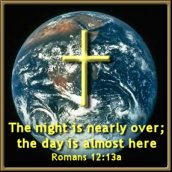The Midtribulation Rapture
The midtribulation rapture theory seems to be a compromise between the pretribulation and the posttribulation views. According to this view the seven-year tribulation is divided into two halves; the first half described as the wrath of man, and the last half as the wrath of God. The rapture of the church will take place at the middle of the tribulation period three-and-one-half years prior to the second advent. J. Dwight Pentecost comments:
Midtribulationism must either deny or at least weaken the dispensational interpretation of the Scriptures, and, (2) deny the strict distinctions between Israel and the church. This is observed in that this position places the church in the first half of the last seven years of the period determined upon Daniel's people and city. (3) The position must rest on a view of the tribulation that divides the period into two separate and unrelated halves, so that the church can go through the first half, even though it has no part in the last half. (4) The position must deny the doctrine of imminence, for all the signs of the first half of the week apply to the church. (5) The position must deny the concept of the church as a mystery, so that the church age may overlap God's program with Israel. (6) The position must depend, to a certain extent, on the spiritualizing method of interpretation. This is particularly evident in the explanation of the portions of Scripture dealing with the first half of the tribulation period.
One of the principal arguments of the midtribulationists is that the rapture will take place at the "last trump," which they identify with the seventh trumpet in Revelation. The midtribulationist views the seventh trumpet of Revelation 11:15 and the last trump of 1 Corinthians 15:52 and 1 Thessalonians 4:16 as the same. Paul Feinberg comments:
If the identification rests on the bare fact that in both passages we have last trumpets, then there is a problem. Gundry points out that if the seventh trumpet comes at the middle of the seventieth week, there is still another trumpet. It is the trumpet with which the angels call God's elect from the four winds after Christ's return (Matt. 24:31). On the other hand, if the identification is based on the fact that both trumpets are the last trumpet for the church, then I think the argument is dubious. There is no question that 1 Corinthians 15:52 and 1 Thessalonians 4:16 deal with the church. The problem relates to the seventh trumpet of Revelation 11:15. Here you have the final trumpet in a series of judgments. On what ground should this trumpet be taken as identical with the last trumpet of 1 Corinthians 15:52?
The seventh trumpet of Revelation 11:15 actually includes the seven vials (Rev. 16:1-21), and covers the rest of the seventieth week period. Included in the seventh trumpet, verses 15-19, is a "panorama of the rest of the book, future events being seen as already present."
Other arguments of midtribulationists include: (1) "the denial of imminence"; (2) "the denial of the church as a mystery"; (3) "the nature of the seals and trumpets" (the mid-trib view believes they "are not manifestations of divine wrath"); (4) "the duration of the tribulation period" (the mid-trib view divides the week into two unrelated parts); and (5) "the chronology of the book of Revelation" (the mid-trib view sees Revelation 11:15-18 as the Rapture, and not the Revelation).
Home
| 